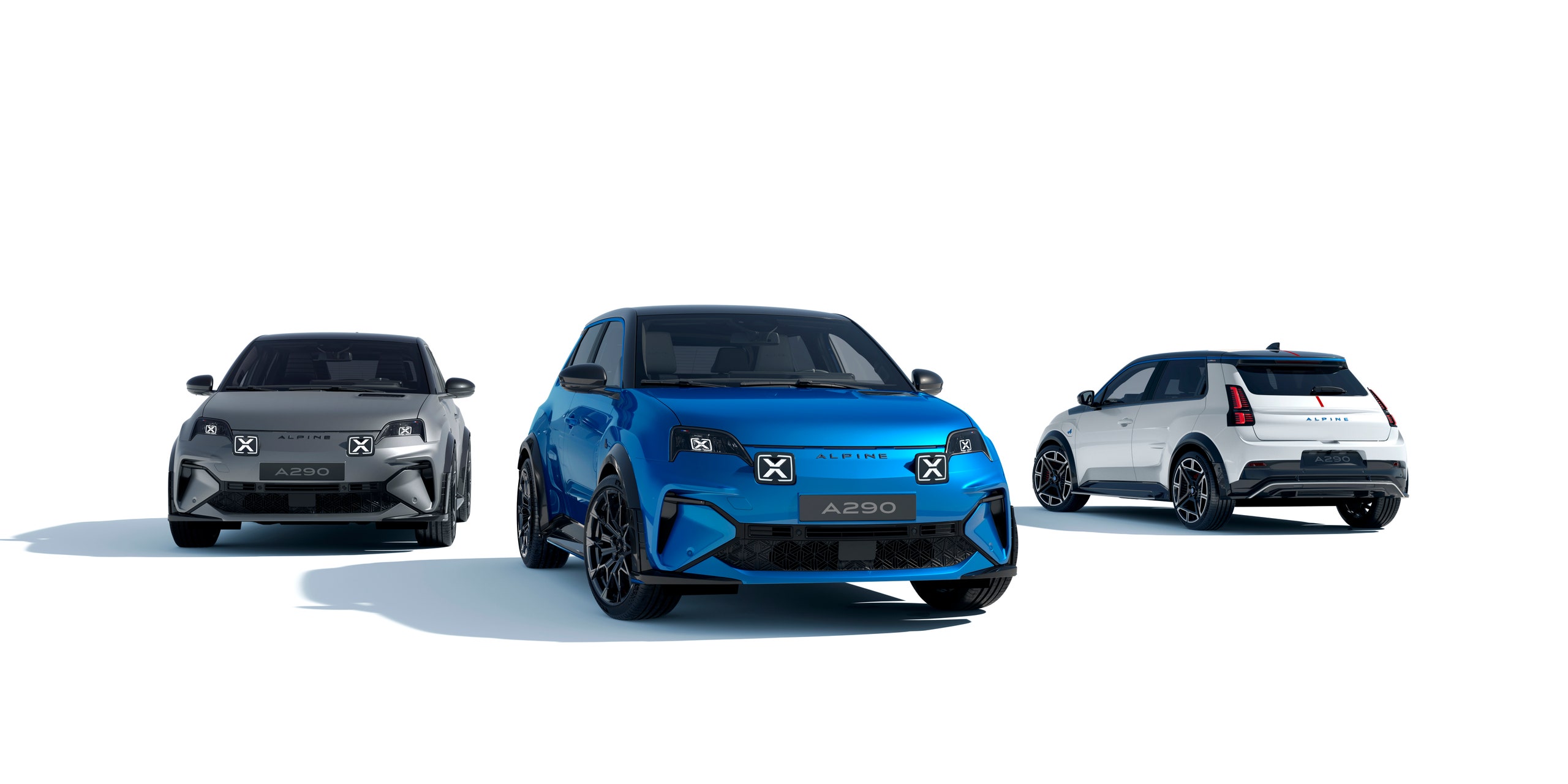Alpine doesn’t release new cars very often. Its last, and until now only new model, the A110, was first launched in 2017. But a lot has changed since then, not least the continuing electrification of the automotive world. Enter the A290, Alpine’s first new car in seven years, and the first in the French brand’s all-electric future lineup.
If the A290 looks familiar, that’s because it’s essentially the sporty version of the new Renault 5 E-Tech, which itself was unveiled in early 2024. Its nostalgic, boxy looks take direct inspiration from its predecessor, the original Renault 5. Once France’s best-selling car, it enjoyed a long reign of success from 1972 all the way until 1996, selling more than 5 million units.
The new R5 will aim to replicate that popularity in pure electric form, with added cuteness supplied by an official “baguette holder” accessory (yes, really), while the Alpine A290’s lineage can be traced to the souped up Renault 5 Alpines and Turbos from the same era.
This is apparent when you see one in the metal. At the A290’s brand-hosted unveiling in Paris, a number of models were presented in various shades, including a new, more vibrant version of “Alpine Blue,” the color found on the brand’s Formula One and Le Mans cars.
The car’s arches are swollen to accommodate the large 21-inch wheels, which sit 60 mm wider than the standard R5. It has flared side skirts, and front and rear spoilers that allude to its performance potential. Most notably are the rear lights, which sit high and long on each edge in reference to the 1980s original.
Next-Gen Hot Hatch
This is where the A290 differs from the A110, which was developed in-house from the ground up. The A290 is actually more of a modification job, with the team at Alpine’s parent company Renault doing much of the work before handing Alpine a rolling chassis, and design, to build on.
The A290 is built on Renault’s new AmpR Small platform, which it shares with the R5. “It's the Renault guys that worked with the 5 from the past,” says Antony Villain, vice president of Alpine design. “Our work was more to bring this car into the Alpine world. We didn’t dig much into the Renault 5 Alpine or Turbo from the past, even if the bodywork is reminiscent. That is more Renault’s [work].”
“We were working on a more progressive and futuristic approach rather than celebrating the past,” Villain adds. “Renault used [the R5] as more of a nod to the icon, but for us it’s really about bringing it into something more contemporary, and in some way closer to the A110.”
We’ll have to wait a little longer to find out whether it’s close to the A110 dynamically. But Alpine has been steadfast in its aims for fun with the A290. It’s designed to be a “new generation hot hatch, which redefines sportiness for the next generation who want electric power,” says Villain. But it’s also designed to be accessible. It doesn’t break any records with its top-of-the-range 220-bhp motor, which takes the car from standstill to 60 mph in 6.4 seconds. This does, however, trump the A290’s nearest rival, the Mini Cooper Electric, which does the same in 7.3 seconds.
The car comes as standard with a 52-kWh battery, for a range of up to approximately 235 miles, which is slightly under the Mini’s 249-mile effort. There’s 100-kW DC fast-charging, which can go from 15 to 80 percent in 30 minutes. For AC charging units, the onboard 11-kW charger can recharge from 50 to 80 percent in one hour and 20 minutes. Over a longer period, it can go from 10 to 80 percent in three hours and 20 minutes.
Drive on a Diet
Where the Alpine really excels is with the car’s weight. It’s just under 300 kilograms lighter than the Mini, weighing 1,479 kilograms. This combined with the bespoke subframe and “skateboard” battery, which sits low underneath the car, should greatly benefit the handling.
Another win over its Renault 5 sibling is a multi-link rear suspension, which promises a pointy front end, while Alpine-engineered front and rear anti-roll bars should add further balance and poise.
Alpine has also spent time perfecting the feel of the brake pedal, promising an “imperceptible natural transition between regenerative braking at the beginning of the pedal travel and hydraulic braking.” Large Brembo units do much of the heavy lifting here, but we’ll let you know whether this has been a success when we review the EV properly.
One stat as a result of this weight loss and superior brake setup is impressive, however: This EV can drop from 62 mph to a standstill in just three seconds—so interested parties should perhaps start training up their neck muscles.
Interior Tech
There are other ways Alpine is looking to engage the driver. There are four driving modes: Save, Normal, Sport, and Personal, the last of which allows a customized throttle response, steering assistance, and “Alpine Driving Sound.” The latter is a newly developed system that accentuates the noise coming from the electric motor and pumps it through the audio system into the car. So, while there’s still trickery going on here, at least the noise generated isn’t entirely fake.
Speaking of audio, Alpine has patriotically partnered with Devialet, a respected French audiophile brand, for its sound system. An optional-extra package, it consists of a 615-watt amplifier, a 30-cm subwoofer, and nine loudspeakers. After a very brief listening session from the back seat, I was left impressed by the clarity of sound and the deep but not overpowering bass. It’s definitely a box to tick on the spec list. As a side note, if you are taller than 5'9", you will struggle for leg room in the back.
If you find yourself behind the wheel, you’ll notice the two large screens, which have become the standard for all new EVs. There’s a 10.1-inch central screen angled toward the driver which displays the Google-based, but attractively Alpine-skinned, operating system. And for those who value tactility, there are a number of physical buttons below it to control the heating and air conditioning. But anyone hoping for Renault 5 Turbo-style speedometers and rev counters will be disappointed with the screen that replaces them.
The steering wheel is large and sporty, and also features an array of buttons. Chief among them are the F1-inspired “RCH” and “OV” controls. The former allows the driver to set the regeneration level, from complete freewheel through to “Level 3,” which will significantly slow the car when off the accelerator pedal. That OV button on the other hand adds an overtake power boost, just like in Pierre Gasly’s A524. Push it for maximum torque and power for up to 10 seconds. It will then require 30 seconds to “cool down” before it can be used again. Important note: It doesn’t add extra power if your foot is already flat to the floor. Essentially this is a novel way of overtaking that Alpine thinks will impress your friends.
Gran Turismo–Style Gaming
There’s much more novelty to be found with what Alpine is dubbing “Challenges.” These are a series of 36 video-game-like “missions” that measure driver skill (to some extent), and can be accessed through the car’s onscreen menus.
They range from an acceleration challenge that measures the time it takes you to go from 0-60 mph, through to endurance challenges that help teach “anticipation in driving.” They are akin to Gran Turismo–style license tests, where drivers are given a bronze, silver, or gold ranking at the end of each.
Live data is taken from the car's array of sensors monitoring agility, g-force, steering, braking and power, endurance, temperature, and tire pressure. This is then combined with onscreen text and animations to first tell you how to nail each challenge, and then let you know whether you have passed or not. Drivers are scored out of 100, and you can't progress on to the next challenge until you pass the last one. You can also share (read: boast about) how you've done with others via an app.
While these challenges at launch will start with a text and animated briefing, then end with data analysis on how drivers have done, Alpine confirmed to WIRED that it is going to roll out live feedback versions of these challenges, where your progress and data are relayed onscreen as you “play” while driving in the tests, as a coming over-the-air update. In theory, this means the A290 could coach you on how to drift perfectly round corners mid-maneuver.
Some of Alpine’s tests are designed for the race track, while others are for the open road. The car will let the driver know when it’s appropriate to accept a closed-road challenge, but somewhat disappointingly won’t be able to intervene if the driver chooses to ignore it—in the same way that launch control and drift modes work in other vehicles. Still, one wonders how insurers will feel about such baked-in encouragement of certain driving styles.
Despite being internal combustion powered, the Alpine A110 is one of the best true sports cars on sale today. Time will tell whether the £36,000 A290 can replicate that success in hot-hatch form while being all electric. We'll find out later in 2024 in the UK and Europe, but the US may well, too, as the brand will be arriving there in 2027.
And, yes, the A290 will indeed be launching with a raft of in-house add-ons—but, very sadly, no bread-carrying accessories.






